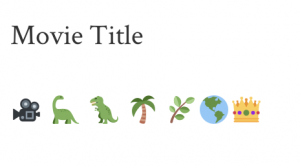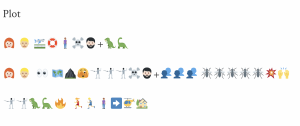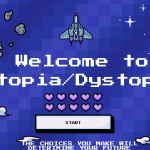

Reflection :
I followed the instructions to not write anything orthographically. I relied on symbols that I thought would be universally known. I have a main image that reoccurs, which allows for my movie to be recognized right away as long as you have watched tv or scrolled the internet the last few weeks. It is a movie that has been just released, so it is likely to be at the forefront of peoples’ minds even if they are not interested in watching the movie. The podcast (McRaney and McCulloch) from last week’s references had Gretchen McCulloch discuss the origin of the emojis and I thought her point about the emoji adding tone of voice to text speak was accurate. I know personally that I add them in to make sure people understand when I am being silly. It is a way to make sure that we do not insult or imply unfriendly tones to our text dialogue. McCulloch also references talking to the head of UNICODE at the time and specifically how their choice of characters always remain within a G rating. Those images that can universally set the tone for the words typed. For the most part, you can find an image you need; they cover the range of emotions and thoughts that we have on average. When it came to the specific plot of my movie it was a bit trickier. There were ideas I wanted to convey such as ‘bad guy” or criminal. The closest they had was a person in a mask, which could actually translate to super hero. I didn’t want the image choice to be ambiguous. What I take from this exercise is that an image cannot necessarily covey everything you need it to. Words have a specificity that really aids in communication, and when you are limited to a specific set of images, you can have unintended misunderstandings.
References
McRaney, David and McCulloch, Gretchen. (Host & Guest). (2012–present). Because Internet [Audio podcast]. You are Not so Smart. https://omny.fm/shows/you-are-not-so-smart/194-because-internet


lianghui zhang
June 26, 2022 — 1:27 am
Hi Marie,
I think the movie is: https://www.imdb.com/title/tt8041270/
I used the hyperlink so that it will not spoil the answer for other people who want to guess it.
You have done a really good job in representing the plot using Emojis. The reoccurring Emojis helped me a lot in guessing the answer. In addition, separating the three scenes into three lines also helped me visualize the progression of the plot.
I agree with you that Emojis are mainly used for conveying emotions and thoughts, so it is difficult to find an accurate symbol for movie elements like the villain. In this case, although Emojis are “images”, there are different from the drawings or photographs that Kress (2005) talked about. Because there is only a limited amount of Emojis, the meanings have to be ill-fitted into the predefined symbols. And the number of Emojis we have is less than the number of English words, so the plot has to be further abstracted from the text description.
Out of the three lines of plots, which line do you think is the most difficult one to recreate? How much time did you spend on choosing the symbols?
Reference:
Kress. (2005). Gains and losses: New forms of texts, knowledge, and learning. Computers and Composition, Vol. 2(1), 5-22.